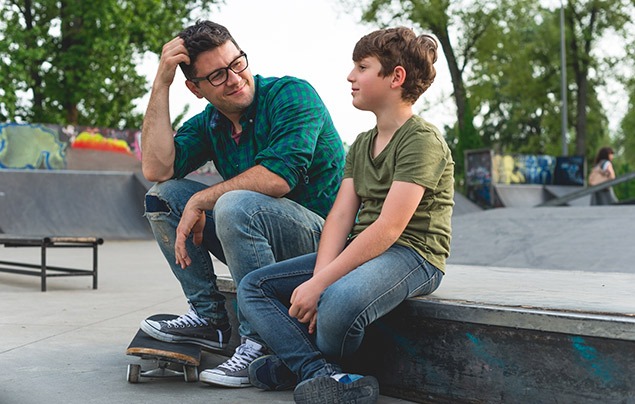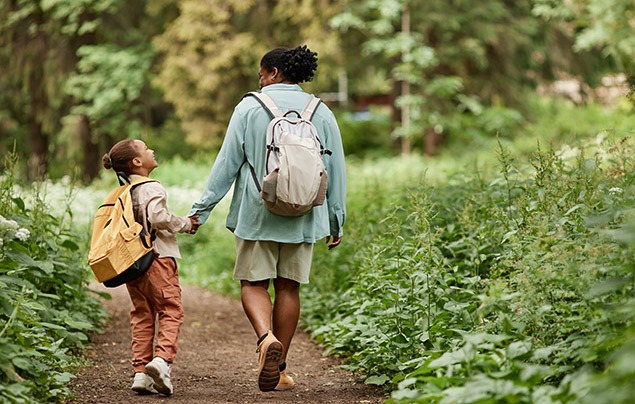Want to communicate better with your kids? Take them outside.
Conversations in nature might help families connect. Here’s why – and how you can get started.
There’s something about hiking in the mountains near his home that gets 12-year-old Henry Van Bibber talking. Time on the trails with his mum and dad is often filled with an endless stream of chatter in which Henry free-associates about his dream home or ideal video game. But sometimes the topics of conversation go deeper.
Last summer, for instance, the family talked about the Black Lives Matter movement and racial inequality. Recently, during a hike on his favourite trail, Henry revealed that he was feeling anxious about starting a new school and making new friends.
“In the past we’ve mostly had conversations about stuff he was hearing on the news or seeing on TV,” says Henry’s dad, Ryan Van Bibber. “But this was like a true window into his day-to-day person. We heard about who he is and the issues that affect him.”
How nature helps families communicate better
It’s no secret that the simple act of going outdoors provides kids with a bounty of cognitive, emotional and physical benefits. Kids who spend time in nature are happier, healthier, smarter, more cooperative, and more creative. Research also shows that getting outside reduces stress, anxiety and depression. Plus, it lowers the risk of childhood obesity and alleviates symptoms of attention deficit hyperactivity disorder.
But now, new data points to another aspect of nature’s powerful nurturing ability: communication. A 2018 study of three- and four-year-old children in Wales found that parents and children communicate better in natural environments compared to indoor environments. More recently, research published in 2021 examining the effects of nature on mother-daughter pairs revealed that spending time outside is a way to promote positive family interactions.
“Nature restores people’s ability to pay attention to conversations and reduces their mental fatigue,” says Dina Izenstark, associate professor of child and adolescent development at San Jose University and one of the authors of the 2021 study. “This can help family members communicate more effectively and get along better with one another.”
Most parents know what it’s like to get one-word answers – or stonewalled completely – when they try to talk to their children. And more parents wish their kids would open up more. The good news is that a simple dose of vitamin N might just help that happen.
Connecting through conversation – no matter where you are
Regardless of where you’re talking to your child, good conversations begin with strong connections. “There’s decades of research showing that having sensitive, timely, responsive interactions with your child will benefit their development,” says cognitive psychologist Merideth Gattis, a professor at Cardiff University in Wales who co-authored the 2018 study. “And parents need to employ a sort of Goldilocks strategy – not too much, not too little, but just right.”
So, what does that look like? According to Jennifer Kolari, a Toronto-based child and family therapist, parents spend a lot of time talking at their kids, telling them what to do or why they should or shouldn’t do something. But to nurture those deeper connections, parents need to be fully present, pausing to listen and respond to their children with compassion and empathy. And that’s when the magic happens.
“Some pretty important chemicals start to flow when you have this connectivity,” says Kolari. For instance, when your child feels heard, their brain is bathed in oxytocin, one of the reward chemicals that makes people feel good. Higher levels of oxytocin can speed up neuroplasticity (which helps kids learn better), inhibit the stress hormone cortisol, and strengthen the immune system.
“Parenting this way also helps children become more emotionally resilient and more emotionally organised while improving their behaviour and social skills,” Kolari says.
Looking for ways to encourage your kids outside for family time? National Geographic Kids magazine (for ages 7-12) and National Geographic Little Kids magazine (for ages 3-6) are packed with brain-boosting articles, games, puzzles and more designed to inspire a lifelong love of nature. Grab a subscription for your family today and sign up to our newsletter for fun family activity ideas delivered direct to your inbox every week.
Nature-powered conversations
But having that strong connectivity doesn’t necessarily mean that your kids are suddenly going to start spilling their guts – or that parents are always going to have the bandwidth to listen. Everything from work to school to technology is vying for our attention. But fortunately, the antidote to all those distractions is right outside your door.
“I often recommend to parents that if you want to have a really connected conversation – or a conversation about something important – take your child into nature,” Kolari says. “Plus, as adults, nature calms us down, too. We’re able to be more present, and that helps us respond to our children instead of reacting. And what happens then is that we end up having a very different type of conversation.”
Why does nature help people communicate better?
In the late ‘80s and early ‘90s, psychologists Rachel and Stephen Kaplan introduced Attention Restoration Theory, which suggested that mental fatigue and concentration can be improved by time in nature. Their research indicated that nature captures our attention effortlessly – an idea they referred to as ‘soft fascination’.
“Unlike sitting in front of the television, where there’s a lot of stimulation coming at you, nature has a different way of grabbing your attention. It’s not as overwhelming,” Gattis says. “Our study built on that research. We made the assumption, therefore, that communicative tasks like taking turns, listening to each other, and responding would improve in an outdoor environment.”
According to Lisa Nisbet, an associate professor of psychology at Trent University who studies people’s connectedness to nature and its link to health and wellbeing, a good amount of evidence indicates that our emotions and behaviours differ when we’re in nature versus indoor environments.
“We’re nicer in nature,” Nisbet says. “Nature affects our wellbeing and our happiness. So, if we feel happier when we’re in nature, then we’re more likely to get along better with others. It makes sense that, because of those positive effects, spending time in nature would improve communication between people as well.”
What’s more, the communication strides you make with your children in the great outdoors often spill over into daily life. Izenstark and her colleagues found that a walk in nature not only improved the mood and attention between mother and daughters during the stroll. They also displayed a greater sense of unity after the walk was over.
Van Bibber, the dad hiking with his son, agrees. “For us, the conversation we had about school that day has become a reference point that we can go back to. We can say to him, ‘Remember what we talked about when we were fossil hunting on the caves trail? You have to be comfortable with yourself in order to make friends.’ or ‘Remember what we talked about in the woods? It’s okay to feel disappointed sometimes.’ That’s a lesson we can go back to with him again and again.”
Getting the conversation started
You don’t need to take your kids on a three-week wilderness trip to get them talking. “If you can’t get to a forest, sit in your garden with your bare feet in the grass,” Kolari says. “There’s a calming energy that just happens.”
Here are some ideas to jump-start those conversations…
Remember when?
Reminiscing about past experiences can be a great way to open up a discussion with your child. In fact, Gattis’ 2018 study had many references to “Do you remember when we…” or “Do you remember when _________ happened?” Those shared memories, or ‘remindings’, as Gattis calls them, are an excellent way for parents and children to connect.
Share something from your own life.
Recount a personal experience or interaction you had recently. Open up about how it impacted you. Your child may interrupt you, but that’s okay. If you tell a story about how someone cut in front of you in the supermarket queue, your child may come back with, “I got so angry today when Elizabeth pushed ahead of me at playtime!”
When I was a kid…
Younger children love hearing stories about when their parents were little. Drawing parallels between your past and their present can inspire kids to talk about their own lives. With older kids, think about some of the academic or social issues they might be facing and share a related tale from your own adolescence.
Model curiosity and awe.
“Look at that cool caterpillar!” “I wonder why that tree’s bark is that colour?” “Whoa! Did you see that big bird?” It’s impossible to ignore the wonders of nature – even if you’re just walking down a city street. Asking questions while modelling your own fascination with the natural world might instigate some cool conversations.
Embrace the silence.
Parents can feel the need to make every moment a teachable one. But don’t fill all the available space with empty chatter when your family is out in nature. “Learn to be quiet,” Kolari says. “You can go for a walk and not even talk. You’re still connecting. There’s magic and beauty in silence.”
















LEAVE A COMMENT
THANK YOU
Your comment will be checked and approved shortly.
WELL DONE,
YOUR COMMENT
HAS BEEN ADDED!
COMMENTS
CUSTOMIZE YOUR AVATAR